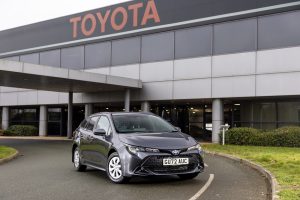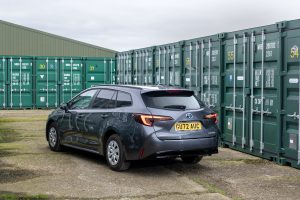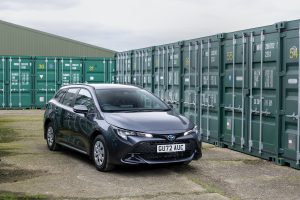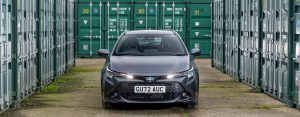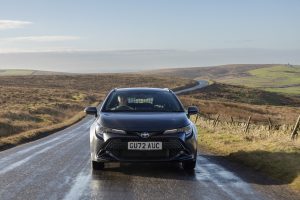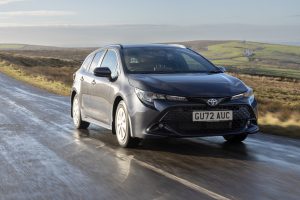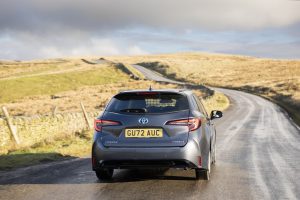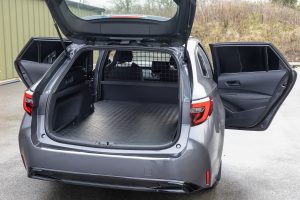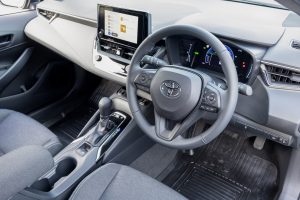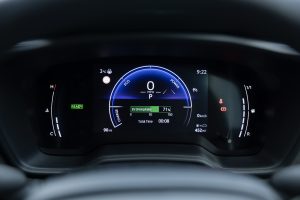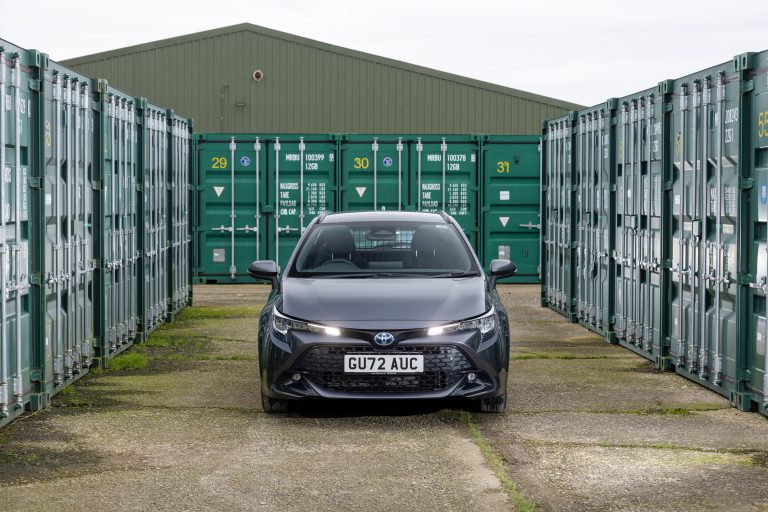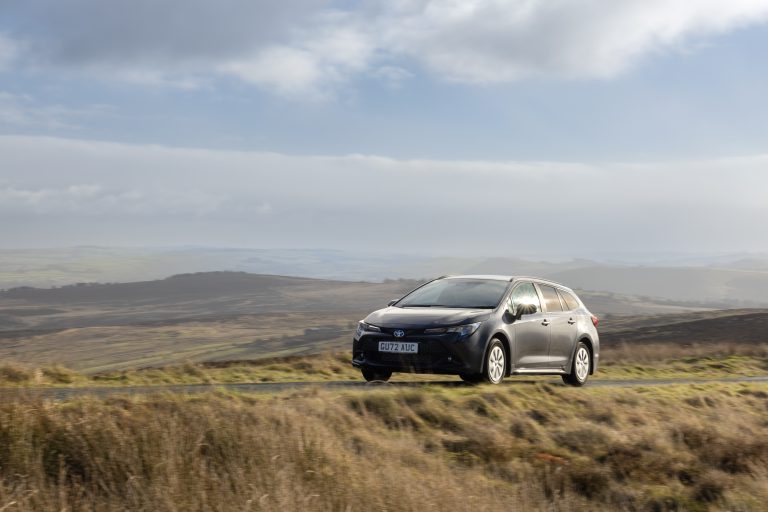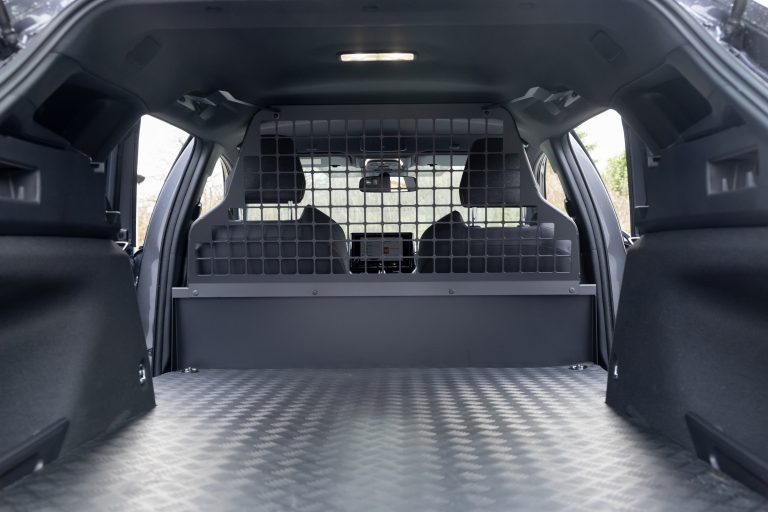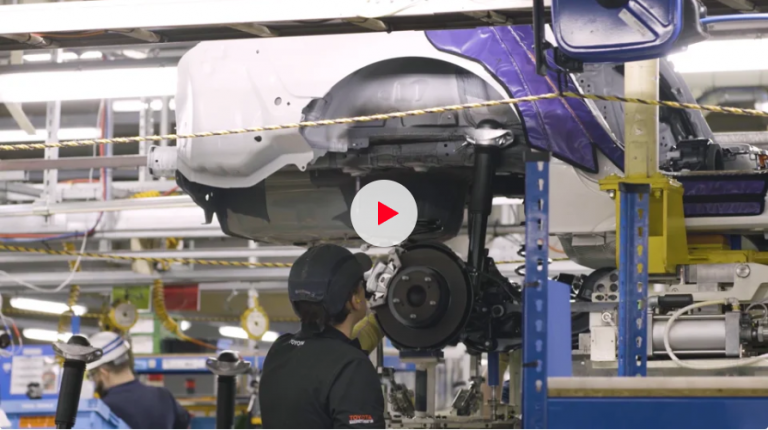The new Corolla Commercial: more power, higher efficiency for Toyota’s hybrid electric van
- Corolla Commercial becomes even more business-user friendly with new, fifth generation Toyota hybrid electric technology
- New 1.8-litre self-charging powertrain delivers more power and a more rewarding drive while preserving its high efficiency
- New model equipped as standard with latest Toyota Safety Sense systems, with increased hazard detection and avoidance capabilities and driver assistance functions
- Load-carrying capacity maintained at 1,326 litres with 425kg maximum payload
- Corolla Commercial developed and produced in the UK at Toyota Motor Manufacturing UK’s Burnaston facility in Derbyshire
- 1.8-litre engines built in North Wales at TMUK’s Deeside plant
INTRODUCTION
Toyota is immediately introducing the benefits of its wider Corolla range updates to the UK-exclusive Corolla Commercial – the market’s first self-charging full hybrid electric van.
The updated 2023 model matches its Hatchback and Touring Sports passenger car counterparts in adopting Toyota’s new fifth generation hybrid technology. The upgraded 1.8-litre powertrain delivers more power, faster acceleration and a more rewarding drive while maintaining the van’s high fuel and emissions efficiency. The system’s principal components have been comprehensively redesigned to save weight, reduce losses and improve performance – changes that include the introduction of a more powerful lithium-ion battery.
Corolla Commercial further gains the latest Toyota Safety Sense package of advanced safety and driver assistance systems, with more functions and increased hazard detection capabilities.
The van’s useful load-carrying qualities are undiminished, with 1,326 litres of loadspace, the ability to carry a 425kg payload and tow up to 750kg. The conversion from Corolla Touring Sports to Commercial includes a rubber load space lining, full bulkhead grille, interior light and 12v power outlet – work that is carried out by Toyota Motor Manufacturing UK in the Business Revenue Centre at its Burnaston car plant in Derbyshire. Corolla’s “home grown” quality also includes an engine supplied by the TMUK Deeside factory in North Wales.
Corolla Commercial offers customers a perfect solution for meeting the need to reduce carbon emissions without compromising the flexibility and reliability businesses – in particular small enterprises and sole traders – require. Toyota’s full hybrid electric system gives a generous all-electric driving capability that’s ideal for urban deliveries, while ensuring there’s always the freedom to make longer trips whenever required, with no need to schedule down-time for recharging.
FIFTH GENERATION TOYOTA HYBRID ELECTRIC SYSTEM
The fifth generation of Toyota’s self-charging full hybrid electric technology is the heart of the new Corolla Commercial. Detailed engineering and design changes deliver a better driving experience, higher performance and improved efficiency. The changes include new power control unit and transaxle designs, a more powerful lithium-ion battery and calibration to achieve a more rewarding driving experience with a closer relationship between the driver’s use of the accelerator and the drive force delivery.
Performance
Total power from the 1.8-litre system is 138bhp, bringing a 1.7-second reduction in the 0-62mph time to 9.4 seconds. CO2 emissions are from 100g/km, with fuel economy from 64.2mpg (all figures WLTP combined cycle).
Hybrid system design
The changes introduced for the fifth generation hybrid electric system include components that weigh less and are more compact – qualities that help maintain efficiency in tandem with the increase in output – but which maintain the reliability that is a hallmark of Toyota’s technology.
A new power control unit (PCU) helps reduce the level of electrical losses in the system (-14 per cent) and maintain fuel efficiency. The unit has a new double-sided cooling system and runs at a higher frequency, reducing its noise level.
The PCU is installed directly above a new transaxle featuring a compact, high-output motor-generator with new internals to improve fuel efficiency and dynamic performance. A new stator coil winding method has helped reduce the motor’s size. The complete transaxle is 15 per cent lighter than before thanks to the use of new materials – its casing is now 20 per cent lighter.
Using low-viscosity oil reduces internal friction and adds to the all-round improvement in efficiency. Other detailed measures include smaller gears with teeth reprofiled to give a larger contact area and a smaller and lighter differential.
Hybrid battery
The new lithium-ion hybrid battery is smaller and lighter but has a higher output – qualities that contribute to both the car’s dynamic performance and its fuel efficiency. Compared to the battery deployed in the previous system, weight has been reduced by 14 per cent while power output has increased by 14 per cent. Toyota has optimised the battery’s cooling path to help prevent deterioration caused by temperature fluctuations and preserve battery life.
A more rewarding driving experience
The advances made with the fifth generation hybrid system include improvements in driveability. Notably, the driver experiences a better relationship between their use of the throttle and vehicle response with more consistent, predictable and controllable performance. A better acceleration feel makes for more confident driving.
This has been achieved by calibrating the throttle better to suit familiar driving scenarios, such as stop-start traffic and frequent changes in speed limits. The acceleration also adapts to up and downhill driving, synchronising the engine speed with the driver’s inputs to give a more natural feel and easier drive. Running at lower rpm also makes the system quieter when driving at highway speeds.
Predictive Efficient Drive
Hybrid battery charging and discharging can be controlled according to the driving situation, with the system gathering and storing data as the car is driven, to help gain better fuel efficiency.
The system registers and stores information on points in regular journeys where the driver always decelerates. As the car approaches a point where data has been obtained, it will recommend the driver comes off the accelerator (shown in the eco-driving guidance in the multi-information display) and then increases engine braking to maximise energy regeneration.
Predictive state-of-charge control predicts downhill sections and traffic congestion on a route planned using the navigation system. This allows for more efficiency battery charge management, for example optimising use of battery charge prior to a long downhill section where more energy can be captured. Using real-time traffic information, the system can also help maintain a certain level of battery charge prior to reaching any congestion. This reduces the need for the engine to be started to charge the battery when caught up in tailbacks.
NEW AND IMPROVED TOYOTA SAFETY SENSE SYSTEMS
The latest developments of Toyota Safety Sense have brought significant improvements to many of its accident detection systems and added new functions that increase safety and provide additional peace of mind. With the benefit of over-the-air updates, software can now be upgraded automatically, with no need for the car to be taken to a service centre.
Corolla Commercial benefits from a new front camera that covers a much wider field ahead of the car, with extended reach both left/right and up/down. The distance of forward detection has been doubled compared to the scope of the previous hardware. Likewise, the coverage of the front millimetre-wave radar has been extended so that it can detect obstacles closer to the front of the car than before. Using Motion 3D and enhanced Deep Neural Network tools has allowed for a wider range of potential hazards to be picked out, including motorcycles and roadside objects such as walls, guard rails, kerbs and utility poles.
This increased detection capability makes the Pre-Collision System (PCS) effective in more urban traffic scenarios, including recognition of potential head-to-head collisions. The Intersection Collision Avoidance can now identify approaching traffic across two lanes, as well as cyclists and vehicles approaching from the side.
The Emergency Steering Assist system helps the driver keep the car within its traffic line when trying to avoid a hazard such as a pedestrian, cyclist, parked car, or – thanks to the detection enhancements – motorcyclist. There’s also a safeguard against sudden, unintended use of the accelerator when moving at low speed, with a new acceleration suppression function.
The Full Range Adaptive Cruise Control (ACC) has been revised to give faster response and to operate in a way that feels more natural to the driver. For example, thanks to earlier detection, when another vehicle enters the car’s lane there is more gradual deceleration. The driver can select a longer vehicle-to-vehicle setting to establish a more comfortable gap and the ACC’s curve speed reduction function is activated earlier, giving smoother speed adjustment when driving through a bend.
New systems have been added for safer overtaking: Overtake Prevention Support prevents unintentional overtaking on the wrong side of a vehicle (“undertaking”); and Preliminary Deceleration/Turn Signal Linked Control helps the driver safely rejoin the traffic lane at an appropriate speed and distance from other vehicles.
The Lane Trace Assist (LTA) has also been adjusted to operate with a more natural feel. It now recognises when the driver has moved out of lane while trying to avoid an obstacle (pedestrian or other road users) and temporarily cancels the Lane Departure Warning. Its lane-centring function has also been changed so that the car will follow a more natural-feeling, off-set line when passing parked vehicles and other roadside obstacles.
When the ACC and LTA are operating, an Emergency Driving Stop system will monitor driver inputs; if these stop (use of steering wheel, brake and accelerator) over a certain time, it will sound a warning and, if the driver doesn’t respond, bring the car slowly to a stop and activate the hazard lights.
The Road Sign Assist has been improved so that the speed limiter can easily be adjusted to match traffic sign information – useful, for example, when driving near schools or entering spaces shared with pedestrians.
Proactive Driving Assist (PDA) is a new function that provides a range of safeguards when driving in low-speed areas such as town centres. Obstacle Anticipation Assist detects obstacles such as parked vehicles, pedestrians and cyclists ahead at an early stage and provides steering and braking support to help the driver avoid approaching too close. Deceleration Assist provides smooth deceleration when the driver comes off the accelerator to slow down for a slower vehicle ahead, or when entering a bend. Steering Assist detects a bend ahead and adjusts steering force to help the driver adopt an appropriate steering angle.
MODEL RANGE AND EQUIPMENT FEATURES
Corolla Commercial is available in a single grade with a standard equipment specification that reflects the model’s close relationship to the passenger, in addition to practical features specific to its role as a load-carrying vehicle for business.
Key features include: –
- Multimedia system with eight-inch display and voice recognition
- Smartphone integration with Apple CarPlay and Android Auto
- Toyota Safety Sense active safety and driver assistance systems
- Over-the-air updates for multimedia and safety system software
- Dual-zone automatic air conditioning
- Heated front seats with power lumbar adjustment
- Reversing camera
- Automatic headlights
- Full metal bulkhead
- Rubber-lined load bay
- Rear window masking film
- Two individual front seats
The new Corolla Commercial is on sale now with a CV on-the-road price of £24,503 (not including VAT).
As part of the Toyota Professional range of LCVs, it is eligible for five years’ free roadside assistance. Toyota Professional is committed to offering appointments at the customer’s convenience, with work carried out by qualified, Toyota-trained technicians. Customers also gain peace of mind and easier budgeting with transparent service pricing according to vehicle type. Access to the help customers need is made easy with a UK network of more than 100 Toyota Professional retailers. Toyota parts delivery is secured within 24 hours , with all items guaranteed for a minimum 12 months.
Up to 10 years manufacturer’s warranty
In common with every new Toyota, the new Corolla Commercial is eligible for Toyota warranty protection for up to 10 years or 100,000 miles (whichever comes first). This comprises an initial three-year manufacturer warranty, followed by up to a further seven years of service-activated warranty.
For the first three years of the car’s life, owners can have it serviced at a place of their choice. When the new car warranty period expires, they can then benefit from an additional 12 months (or 10,000 miles) warranty when their vehicle has a qualifying service at an authorised Toyota workshop. The warranty is provided at no extra cost, up to a limit of 10 years/100,000 miles. Terms and conditions apply; full details are available at www.toyota.co.uk.
COROLLA COMMERCIAL PRODUCTION AT TMUK BURNASTON
The concept of a Corolla-derived hybrid electric van has been a UK initiative from the outset. Having gained a positive response from established customers to the idea of Toyota applying its hybrid technology to a commercial vehicle, a prototype was produced and revealed for the first time at the 2021 Commercial Vehicle Show. With no negative feedback – people warmly welcomed the prospect of a van with hybrid electric power – Toyota launched production in May 2022.
Corolla Commercial is manufactured at the Toyota Manufacturing UK (TMUK) car plant at Burnaston in Derbyshire. It is derived from the Corolla Touring Sports, which is produced on the same TMUK assembly line as the Corolla Hatchback; vehicles that are assigned for conversion go through the same process as the passenger models, but with no fitment of rear seats or rear seatbelts.
The conversion work is carried out in TMUK’s Business Revenue Centre. Here the vehicles are fitted with a flat-floor load space with a tough rubber lining, a steel bulkhead and opaque film to cover the rear windows. These measures ensure the Toyota meets N1 type approval as a goods vehicle. The work is carried out by trained and experienced Toyota technicians and the van undergoes the same rigorous quality inspection checks as its passenger vehicle counterparts.
TMUK Business Revenue Centre
The Business Revenue Centre (BRC) has been developed to diversify the work undertaken by TMUK at Burnaston, beyond the production of the hybrid electric Corolla Hatchback and Touring Sports. Using a dedicated area within the plant complex, it provides services including the reconditioning of pre-owned vehicles and fitment of accessories to new vehicles that have arrived in the UK via Toyota’s Portbury import depot.
The unit serves as a one-stop-shop to prepare vehicles to customer specifications, including spray-on Line-X bed liners for the Hilux pick-up, ply-linings and racking for vans, amber light bars, liveries and vehicle wraps.
Corolla is an increasingly popular choice for public sector fleets, in particular for police and other emergency services. The BRC has the capability to install many of the special features they require, including lighting, liveries and electronics.
These services offer direct benefits to the customer: there is no third-party involvement, so the process is quicker and at the end of the job, there is just one invoice to pay. There is also the peace of mind that all work meets Toyota’s high quality, reliability and durability standards and is carried out by an expert team.
ENDS
Note to editors: a full Corolla Commercial press kit with technical and equipment specifications and a suite of high-resolution images are now available at media.toyota.co.uk.

